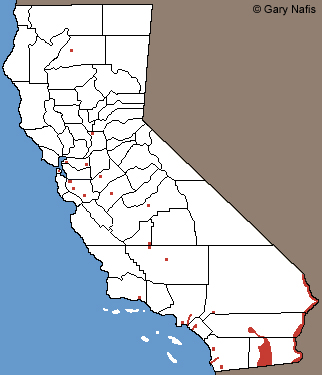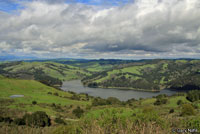|
This species has been introduced into California. It is not a native species.
|
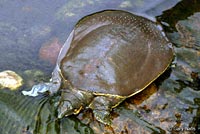 |
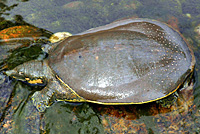 |
 |
| Adult, Imperial County © Gary Nafis. Specimen courtesy of Jeff Lemm & Rick Sturm |
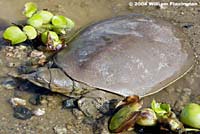 |
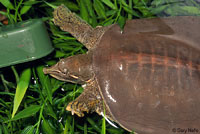 |
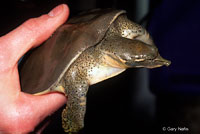 |
Adult Imperial County
© William Flaxington |
Captive adult, specimen courtesy of Tim Burkhardt © Gary Nafis |
 |
 |
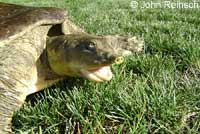 |
Adult, Kern County © John Reinsch
|
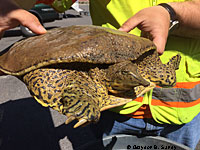 |
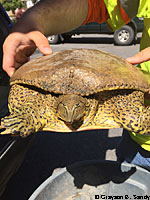 |
 |
| Adult, Santa Clara County © Grayson B. Sandy |
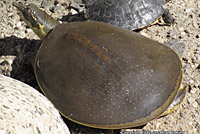 |
 |
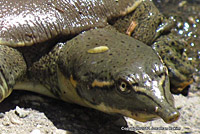 |
| Adult, Los Angeles County © Jonathan Hakim |
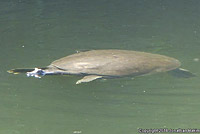 |
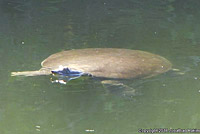 |
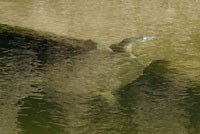 |
| Adult in pond, Los Angeles County © Jonathan Hakim |
Adult resting just below the surface of an irrigation canal in Imperial County that kept ducking underwater whenever I tried to photograph it. (This species can be very wary.) |
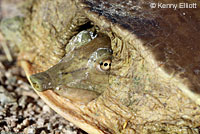 |
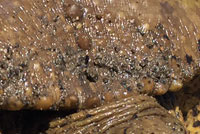 |
|
| Adult, Imperial County © Kenny Elliott |
© Grayson B. Sandy
This close-up of the leading edge of the shell above the head shows the small conical "spines" that give the species its common name.
|
|
| |
|
|
| Texas Spiny Softshells From Outside California |
 |
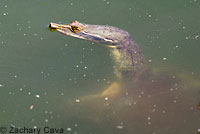 |
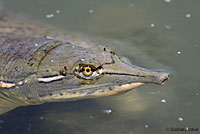 |
| Adult, Clark County, Nevada © Zachary Cava |
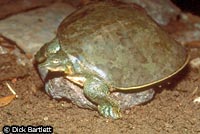 |
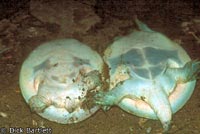 |
|
Adult female, Brewster County, Texas
© Dick Bartlett |
Adult female (left) and male (right)
Brewster County, Texas © Dick Bartlett |
|
| |
|
|
| Habitat |
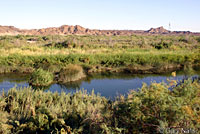 |
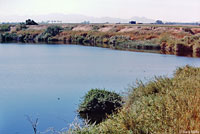 |
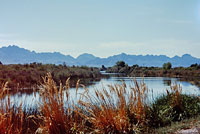 |
| Habitat, Colorado River, Imperial County |
Habitat, Imperial County lake |
Habitat, Colorado River, Imperial County |
|
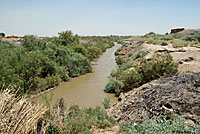 |
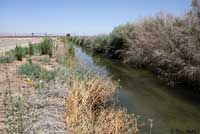 |
Habitat, San Pablo Reservoir,
Contra Costa County
|
Habitat, agricultural drain,
Imperial County
|
Habitat, agricultural irrigation ditch,
Imperial County
|
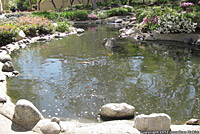 |
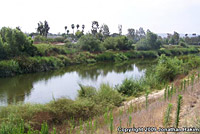 |
 |
| Artificial pond habitat, Los Angeles County © Jonathan Hakim |
Habitat, Orange County
© Jonathan Hakim |
Urban water channel habitat, Orange County © John Gilkerson |
| |
 |
|
| |
Habitat, agricultural irrigation ditch, Imperial County |
|
|
|
|
| Description |
| |
| Size |
5 - 21 inches in shell length (12.7 - 53.3 cm). (Stebbins 2003)
|
| Appearance |
A very flat turtle with a rounded, leathery-skinned, flexible, shell which is keelless and unhinged.
The snout is long with open nostrils on the end.
The limbs are flat with broadly-webbed feet.
There are pale conical spiny projections (tubercles) along the leading edge of the carpace (shell) above the head, and smaller spines on the rear of the carapace. These are the spines that give the species it's common name.
|
| Color and Pattern |
Color is olive, brown or grayish, sometimes with dark markings which fade with age.
The head and limbs are olive to gray with dark markings.
Two dark-bordered light stripes mark each side of the head, extending from the back of the eye and from the back of the angle of the jaw.
The shell has a yellowish border with a dark line around it.
The carapace is rimmed with pale coloring which is four to five times wider on the rear than on the front and sides.
The plastron is yellowish and unmarked.
|
| Male / Female Differences |
Males are smaller than females with a thick tail that extends beyond the carapace, and their pattern is more contrasted than that of females.
The shell has a sandpaper-like texture.
Females become more blotched and mottled as they get older and have a smoother shell with well-developed warts on the front edge.
|
| Young |
Juveniles have prominent dark markings on the head and the limbs and black spots on the shell.
|
| Life History and Behavior |
Activity |
Diurnal.
Thoroughly aquatic, but basks out of the water.
Active most of the year, becoming dormant in cold temperatures.
Often remains hidden underwater with the snout extended up to the surface to breathe. |
| Turtles Walking on Land Do Not Always Need to be Picked Up and Rescued |
| Turtles sometimes leave the water to search for food, a better place to live, a mate, or to lay their eggs in the spring - typically from March to June. If you see a turtle walking on the land, it is probably not sick or lost, so the best thing you can do for the turtle is to leave it alone. Some people want to help a turtle they think is in danger by picking it up and bringing it home or to a wildlife rehabilitation center, but most of the time this harms the turtle by removing it from the wild without reason. Sometimes turtles do get lost or stranded in yards or on busy roads or somewhere where they may be in danger. If you find one in such a situation, it's ok to move it out of danger, but it's best to leave it in a safe place as close to where you found it as possible. |
| Defense |
Difficult to approach, moves very fast on land and in the water.
Capable of scratching vigorously and producing a painful bite if handled. |
| Diet and Feeding |
Predominately carnivorous. Eats insects, crayfish, worms, snails, fish, frogs, tadpoles, and reptiles.
Both actively hunts its prey and sits still to ambush passing prey. May also scavenge its food. |
| Reproduction |
From May to August, females crawl onto land to lay 1 or 2 clutches of 3 - 39 eggs on exposed, sunny, sandy banks. Hatchlings emerge from August to October.
|
| Habitat |
In California, it is found in permanent, not temporary, rivers, agricultural canals, drainage ditches, artificial lakes and ponds. Prefers still water with a muddy, sandy, or gravelly bottom, and aquatic vegetation.
|
| Geographical Range |
The species Apalone spinifera - Spiny Softshell, ranges widely through most of the central and southeastern part of the United States with isolated populations in Montana and extreme southern Canada north of New York, and ranging south into northeastern Mexico.
The subspecies Apalone spinifera emoryi, Texas Spiny Softshell, is native to the Rio Grande and Pecos River drainages in Texas and New Mexico, and the lower Rio Grande Valley in Texas, and northern Mexico. It has also been introduced into parts of Arizona, New Mexico, Nevada, Utah, and Baja California.
Range in California
First introduced into the lower Colorado river, Apalone spinifera emoryi has extended its range west into the Imperial Valley and north to the Salton Sea in Imperial and Riverside Counties and continues to spread farther north in the Coachella Valley.
"Spiny Softshells were introduced to the Colorado and Gila rivers in Arizona around 1900 (Miller 1946, Bury and Luckenbach 1976). From the Colorado River, they presumably moved through irrigation canals and/or the New and Alamo Rivers from Mexico to Imperial County. Museum records show that this species had colonized the Imperial Valley by the 1940s and 1950s."
(David M. Goodward and Mihael D. Wilcox. The Rio Grande leopard frog (Lithobates berlandieri) and other introduced and native riparian herpetofauna of the Coachella Valley, Riverside County, California. California Fish and Game 105(2):48-71; 2019)
Apalone spinifera have also been observed in scattered locations in the central valley and around the SF Bay Area, where they are probably released pets and may not be established. Because of the similarity of Texas Spiny Softshells to other kinds of softshell turtles that are kept as pets and may be abandoned in the state, it's hard to know exactly what kind of softshell turtle is found at any location. My range maps should be considered incomplete, and it's likely that not all of the locations shown represent established populations.
|
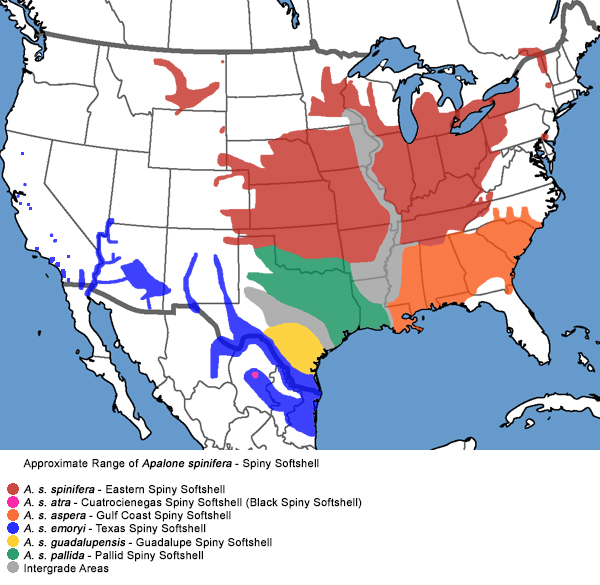 |
| Notes on Taxonomy |
Six subspecies are recognized including one endemic in Mexico.
The former subspecies A. s. hartwegi - Western Spiny Softshell, was synonymized with A. s. spinifera in 2008 by McGaugh et al. (2008, Zoologica Scripta 37:289-304)
Formerly classified in the genus Trionyx (Trionyx spinifera emoryi)
Alternate and Previous Names (Synonyms)
Apalone spinifera - Spiny Softshell Turtle (Stebbins & McGinnis 2012)
Trionyx spiniferus emoryi - Texas Spiny Softshell (Stebbins 1985, 2003)
Trionyx spiniferus emoryi - Texas Softshell (Stebbins 1966)
Trionyx ferox emoryi - Spiny Soft-shelled Turtle (Stebbins 1954)
|
| Conservation Issues (Conservation Status) |
| None |
|
|
Taxonomy |
| Family |
Trionychidae |
Softshell Turtles |
Bell, 1828 |
| Genus |
Apalone |
North American Softshells |
Rafinesque, 1832 |
| Species |
spinifera |
Spiny Softshell |
(LeSueur, 1827) |
Subspecies
|
emoryi |
Texas Spiny Softshell |
(Agassiz, 1857) |
|
Original Description |
Apalone - Rafinesque, 1832 - Atlantic J. Friend Knowledge Philadelphia, Vol. 2, No. 2, p. 64
Apalone spinifera - (Le Sueur, 1827) - Mem. Mus. Hist. Nat. Paris, Vol. 15, p. 258, pl. 6
Apalone spinifera emoryi - (Agassiz, 1857) - Contr. Nat. Hist. U. S., Vol. 1, p. 407; Vol. 2, pl. 6, figs. 4 and 5
from Original Description Citations for the Reptiles and Amphibians of North America © Ellin Beltz
|
|
Meaning of the Scientific Name |
Apalone - Greek - apalos = soft, tender - referring to the soft shell
spinifera - Latin - spina- = horn or spine + -ifer = bearing - refers to the spine-like tubercules along front edge of upper shell
emoryi - honors Emory, William H.
from Scientific and Common Names of the Reptiles and Amphibians of North America - Explained © Ellin Beltz
|
|
Alternate Names |
Formerly Trionyx spiiferus emoryi
|
|
Related or Similar California Turtles |
Apalone ferox - Florida Softshell
Florida Softshells have tubercles on the front of the carapace which are not present on the Spiny Softshell.
|
|
More Information and References |
California Department of Fish and Wildlife
Resources List
USGS
Hansen, Robert W. and Shedd, Jackson D. California Amphibians and Reptiles. (Princeton Field Guides.) Princeton University Press, 2025.
Stebbins, Robert C., and McGinnis, Samuel M. Field Guide to Amphibians and Reptiles of California: Revised Edition (California Natural History Guides) University of California Press, 2012.
Stebbins, Robert C. California Amphibians and Reptiles. The University of California Press, 1972.
Flaxington, William C. Amphibians and Reptiles of California: Field Observations, Distribution, and Natural History. Fieldnotes Press, Anaheim, California, 2021.
Nicholson, K. E. (ed.). 2025. Scientific and Standard English Names of Amphibians and Reptiles of North America North of Mexico, with Comments Regarding Confidence in Our Understanding. Ninth Edition. Society for the Study of Amphibians and Reptiles. [SSAR] 87pp.
Samuel M. McGinnis and Robert C. Stebbins. Peterson Field Guide to Western Reptiles & Amphibians. 4th Edition. Houghton Mifflin Harcourt Publishing Company, 2018.
Stebbins, Robert C. A Field Guide to Western Reptiles and Amphibians. 3rd Edition. Houghton Mifflin Company, 2003.
Behler, John L., and F. Wayne King. The Audubon Society Field Guide to North American Reptiles and Amphibians. Alfred A. Knopf, 1992.
Robert Powell, Roger Conant, and Joseph T. Collins. Peterson Field Guide to Reptiles and Amphibians of Eastern and Central North America. Fourth Edition. Houghton Mifflin Harcourt, 2016.
Powell, Robert., Joseph T. Collins, and Errol D. Hooper Jr. A Key to Amphibians and Reptiles of the Continental United States and Canada. The University Press of Kansas, 1998.
Bartlett, R. D. & Patricia P. Bartlett. Guide and Reference to the Turtles and Lizards of Western North America (North of Mexico) and Hawaii. University Press of Florida, 2009.
Carr, Archie. Handbook of Turtles: The Turtles of the United States, Canada, and Baja California. Cornell University Press, 1969.
Ernst, Carl H., Roger W. Barbour, & Jeffrey E. Lovich. Turtles of the United States and Canada. Smithsonian Institution 1994.
(2nd Edition published 2009)
Lemm, Jeffrey. Field Guide to Amphibians and Reptiles of the San Diego Region (California Natural History Guides). University of California Press, 2006.
|
|
|
The following conservation status listings for this animal are taken from the July 2025 State of California Special Animals List and the July 2025 Federally Listed Endangered and Threatened Animals of California list (unless indicated otherwise below.) Both lists are produced by multiple agencies every year, and sometimes more than once per year, so the conservation status listing information found below might not be from the most recent lists, but they don't change a great deal from year to year.. To make sure you are seeing the most recent listings, go to this California Department of Fish and Wildlife web page where you can search for and download both lists:
https://www.wildlife.ca.gov/Data/CNDDB/Plants-and-Animals.
A detailed explanation of the meaning of the status listing symbols can be found at the beginning of the two lists. For quick reference, I have included them on my Special Status Information page.
If no status is listed here, the animal is not included on either list. This most likely indicates that there are no serious conservation concerns for the animal. To find out more about an animal's status you can also go to the NatureServe and IUCN websites to check their rankings.
Check the current California Department of Fish and Wildlife sport fishing regulations to find out if this animal can be legally pursued and handled or collected with possession of a current fishing license. You can also look at the summary of the sport fishing regulations as they apply only to reptiles and amphibians that has been made for this website.
This turtle is not included on the Special Animals List, which indicates that there are no significant conservation concerns for it in California.
|
| Organization |
Status Listing |
Notes |
| NatureServe Global Ranking |
|
|
| NatureServe State Ranking |
|
|
| U.S. Endangered Species Act (ESA) |
|
|
| California Endangered Species Act (CESA) |
|
|
| California Department of Fish and Wildlife |
|
|
| Bureau of Land Management |
|
|
| USDA Forest Service |
|
|
| IUCN |
|
|
|
|
